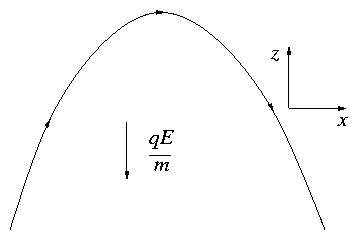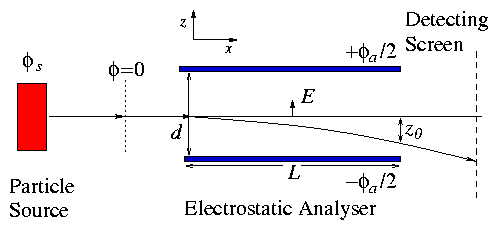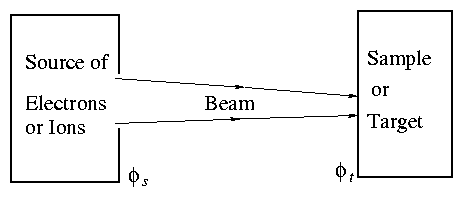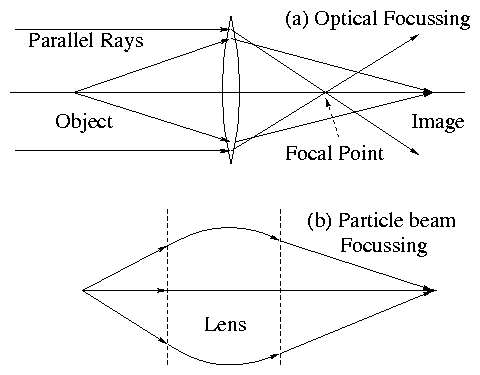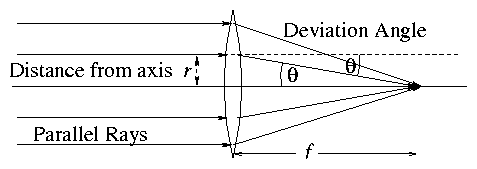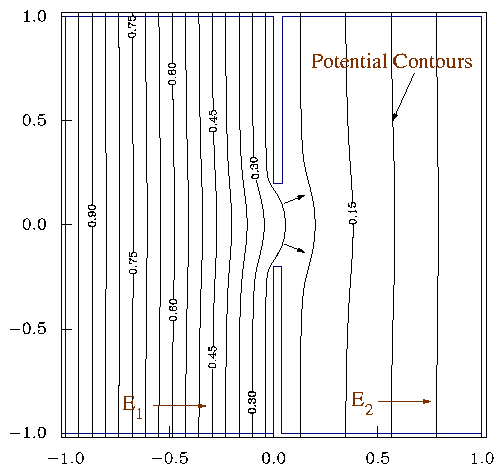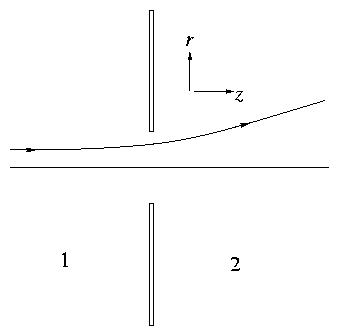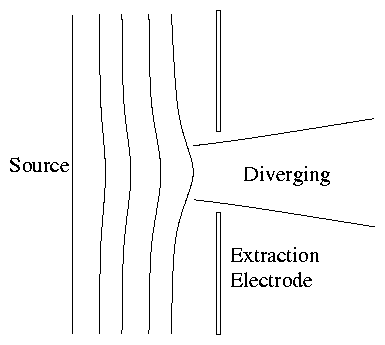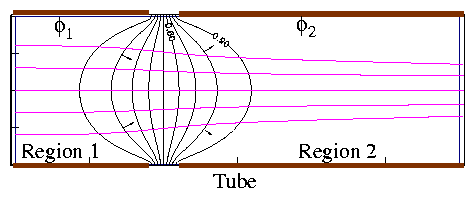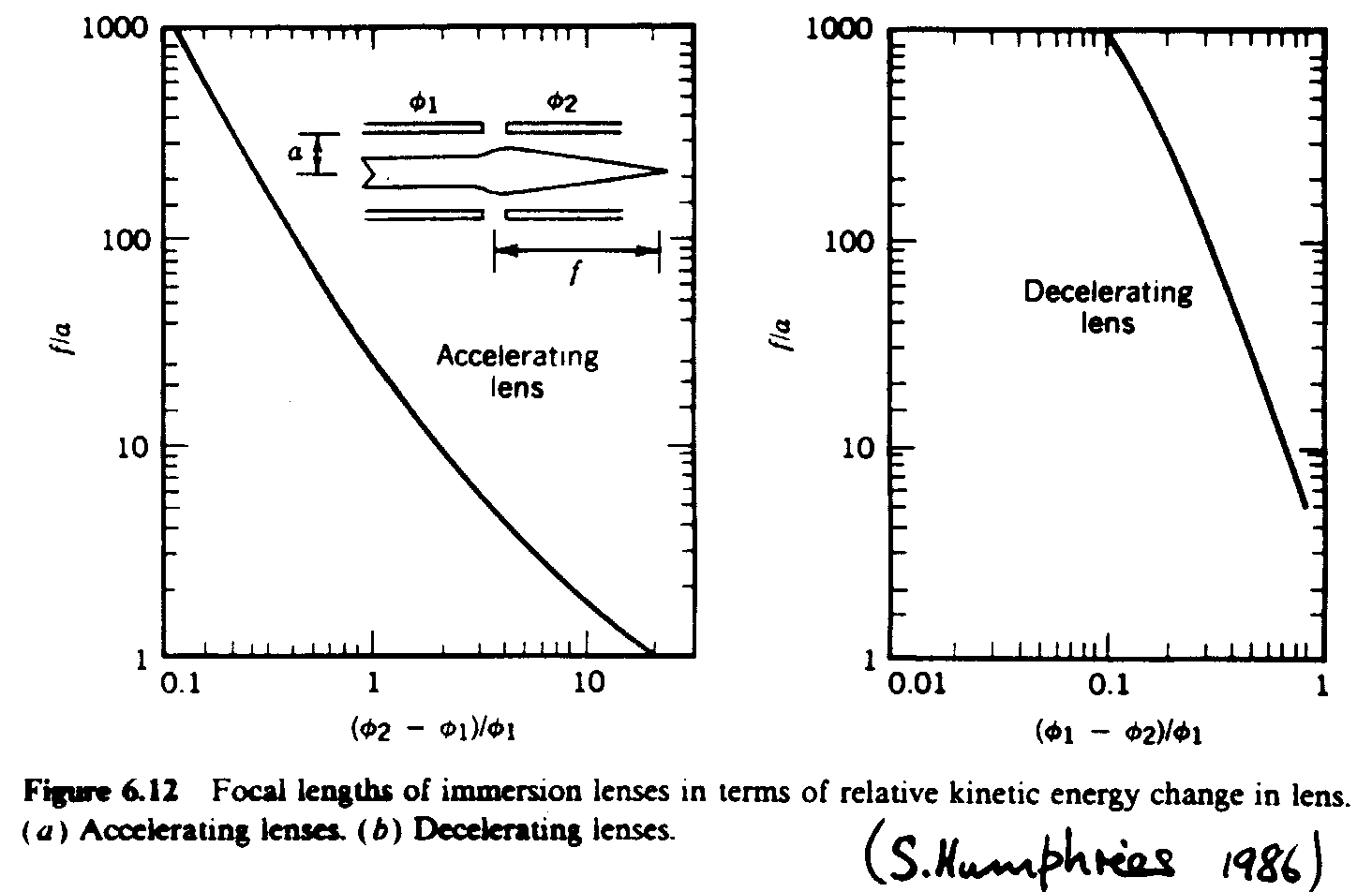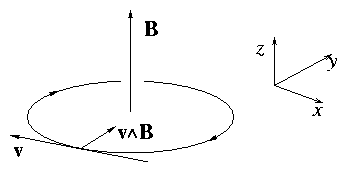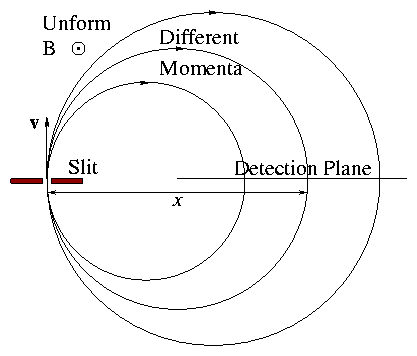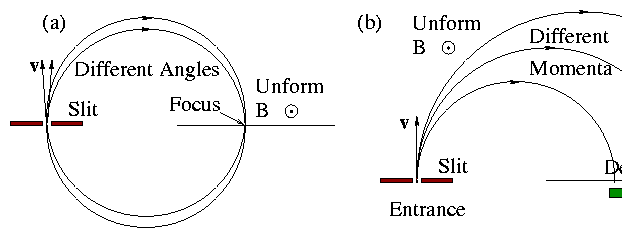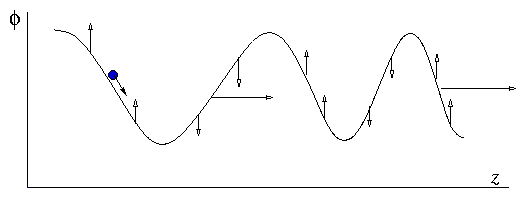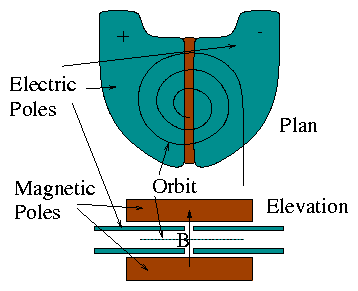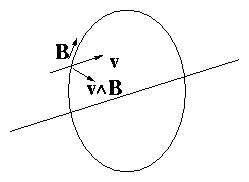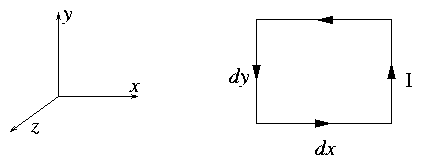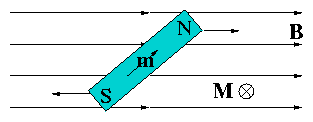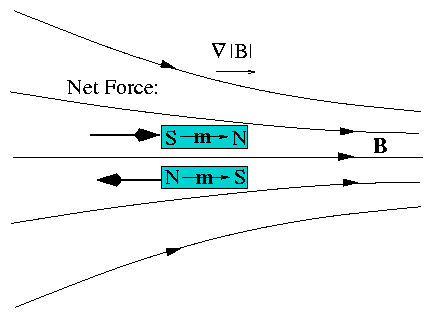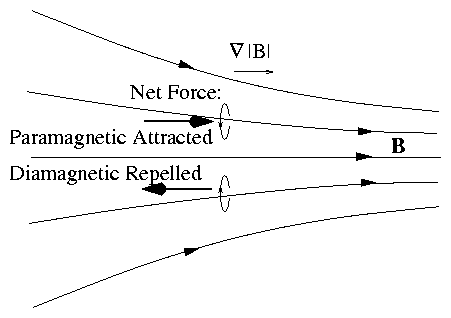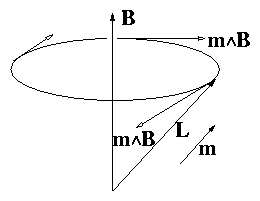Chapter 2
Particle Motion in Electric and Magnetic Fields
Considering E and B to be given, we study the trajectory
of particles under the influence of Lorentz force
2.1 Electric Field Alone
Orbit depends only on ratio q/m.
Uniform E ⇒ uniform acceleration.
In one-dimension z, Ez trivial.
In multiple dimensions directly analogous to particle moving
under influence of gravity.
Acceleration gravity g ↔ q/m E.
Orbits are parabolas.
Figure 2.1:
In a uniform electric field, orbits
are parabolic, analogous to gravity.
|
P.E. = q ϕ electric potential |
| (2.3) |
[Proof if needed, regardless of E spatial variation,
i.e. 1/2 mv2 + q ϕ = const.]
A particle gains kinetic energy qϕ when falling through a
potential drop −ϕ.
So consider the acceleration and subsequent analysis of particles
electrostatically:
Figure 2.2:
Schematic of electrostatic
acceleration and analysis.
Supposing Ea, field of analyser, to be purely ∧z, this
velocity is subsequently constant.
Within the analyser
|
m |
dvz
dt
|
= q Ea⇒ vz = |
q
m
|
Ea t = |
q
m
|
Ea |
x
vx
|
. |
| (2.7) |
So
|
z = | ⌠
⌡
|
vz dt = |
q
m
|
Ea |
t2
2
|
= |
q
m
|
Ea |
1
2
|
|
x2
vx2
|
. |
| (2.8) |
Hence height at output of analyser is
| |
|
|
|
q
m
|
Ea |
1
2
|
|
L2
vx2
|
= |
q
m
|
Ea |
1
2
|
L2 |
m
2qϕs
|
|
| |
| |
|
| − |
1
4
|
|
Ea
ϕs
|
L2 = + |
1
4
|
|
ϕa
ϕs
|
|
L2
d
|
|
| | (2.9) |
|
using Ea = −ϕa / d.
Notice this is independent of q and m!
We could see this directly by eliminating the time from our fundamental
equations noting
|
|
d
dt
|
= v |
d
dl
|
( = v. ∇) with v = |
⎛
√
|
|
or v = |
⎛
√
|
|
|
| (2.10) |
if there is initial energy Es.
So equation of motion is
|
|
m
q
|
|
⎛
√
|
|
|
d
dl
|
| ⎛
⎜
⎝
|
⎛
√
|
|
|
d
dl
|
x | ⎞
⎟
⎠
|
= 2 |
√
|
ϕs − ϕ
|
|
d
dl
|
|
√
|
ϕs − ϕ
|
|
dx
dl
|
=Ea = − ∇ϕ , |
| (2.11) |
which is independent of q and m.
Trajectory of particle in purely electrostatic field depends only on
the field (and initial particle kinetic energy/q).
If initial energy is zero, can't deduce anything about q,m.
2.2 Electrostatic Acceleration and Focussing
Accelerated charged particle beams are widely used in science
and in everyday applications.
Examples:
X-ray generation from e-beams (Medical, Industrial)
Electron microscopes
Welding. (e-beam)
Surface ion implantation
Nuclear activation (ion-beams)
Neutron generation
Television and (CRT) Monitors (fading!)
For applications requiring <~ few hundred keV energy
electrostatic acceleration is easiest, widest used. Schematically
Figure 2.3:
Obtaining defined energy from
electrostatic acceleration is straightforward in principle. Beam
focussing and transport to the target is crucial.
Figure 2.4:
Analogy between optical and
particle-beam focussing.
Figure 2.5:
Requirement for focussing is that
the angular deviation of the path should be a linear function of the
distance from the axis.
and for small angles, θ, r = f θ.
This linear dependence (θ = r/f)) of the
deviation θ, on distance from the axis, r, is the key property.
Electrostatic Lens would like to have (e.g.)
but the lens can't have charged solids in its middle because the beams
must pass through so (initially) ρ = 0 ⇒ ∇. E
= 0.
Consequently pure Er is impossible
(0 = ∇. E
= 1/r ∂(r Er)/ ∂r = 2Ea /a ⇒ Ea = 0).
For an axisymmetric lens (∂/∂θ = 0) we must
have both Er and Ez.
Figure 2.6:
Potential variation near an
aperture between two regions of different electric field gives rise to
focussing.
Calculating focal length of aperture Radial acceleration.
Figure 2.7:
Coordinates near an aperture.
So
|
|
dvr
dz
|
= |
1
vz
|
|
dvr
dt
|
= |
q
m
|
|
Er
vz
|
|
| (2.15) |
But
|
∇. E= 0 ⇒ |
1
r
|
|
∂( r Er )
∂r
|
+ |
∂Ez
∂z
|
= 0 |
| (2.16) |
Near the axis, only the linear part of Er is important
i.e.
|
Er (r, z) ≅ r |
∂Er
∂r
| ⎢
⎢
|
r=0
|
|
| (2.17) |
So
|
|
1
r
|
|
∂
∂r
|
r Er ≅ 2 |
∂Er
∂r
| ⎢
⎢
|
r=0
|
|
| (2.18) |
and thus
|
2 |
∂Er
∂r
| ⎢
⎢
|
r=0
|
+ |
∂Ez
∂z
|
= 0 |
| (2.19) |
and we may write Er ≅ − 1/2 r ∂Ez/∂z.
Then
|
|
dvr
dz
|
= − |
q r
2mvz
|
|
∂Ez
∂z
|
, |
| (2.20) |
which can be integrated approximately assuming that variations in
r and vz can be neglected in lens to get
|
δvr = [ vr ]finalinitial = |
− q r
2mvz
|
[Ez ]21 |
| (2.21) |
The angular deviation is therefore
|
θ = |
− δvr
vz
|
= |
+q r
2mvz2
|
[Ez2 − Ez1 ] |
| (2.22) |
and the focal length is f = r/θ
|
f = |
2mvz2
q( Ez2 − Ez1 )
|
= |
4 E
q ( Ez2 − Ez1 )
|
|
| (2.23) |
When E1 is an accelerating region and E2 is zero or small the
lens is diverging.
This means that just depending on an extractor electrode to form
an ion beam will give a diverging beam.
Figure 2.8: The extraction electrode alone
always gives a diverging beam.
Need to do more focussing down stream: more electrodes.
2.2.1 Immersion Lens
Two tubes at different potential separated by gap
Figure 2.9:
An Immersion Lens consists of
adjacent sections of tube at different potentials.
- vz is not constant.
- r is not constant.
Consider an accelerating gap: q(ϕ2 − ϕ1) < 0.
Effect (1)
ions are converged in region 1, diverged in region 2.
However because of z-acceleration, vz is higher in region 2.
The diverging action lasts a shorter time. Hence overall
converging.
Effect (2)
The electric field Er is weaker at smaller r.
Because of deviation, r is smaller in diverging region.
Hence overall converging.
For a decelerating gap you can easily convince yourself that
both effects are still
converging.
[Time reversal symmetry requires this.]
One can estimate the focal length as
|
|
1
f
|
≅ |
3
16
|
|
q2
E2
|
| ⌠
⌡
|
| ⎛
⎝
|
∂ϕ
∂z
| ⎞
⎠
|
2
| ⎢
⎢
|
r=0
|
dz (for weak focussing) |
| (2.24) |
but numerical calculations give the values in figure 2.10 where
ϕ1 = E/q. Here E is the energy in region 1.
Figure 2.10:
Focal length
of Electrostatic Immersion Lenses. Dependence on energy per unit
charge (ϕ) in the two regions, from S.Humphries 1986
2.2.2 Alternating Gradient Focussing
Idea is to abandon the cylindrically symmetric geometry so as to obtain
stronger focussing.
Consider an electrostatic configuration with Ez = 0
and
|
Ex = |
dEx
dx
|
x with |
dEx
dx
|
= const. |
| (2.25) |
Since ∇. E
= 0, we must have
|
|
dEx
dx
|
+ |
dEy
dx
|
= 0 ⇒ |
dEy
dy
|
= const ⇒ Ey = − |
dEx
dx
|
y |
| (2.26) |
This situation arises from a potential
|
ϕ = ( x2 − y2 ) | ⎛
⎝
|
1
2
|
|
dEx
dx
| ⎞
⎠
|
|
| (2.27) |
so equipotentials are hyperbolas x2 − y2 = const. If
qdEx/dx is negative, then this field is converging
in the x-direction, but dEy/dy = − dEx/dx, so
it is, at the same time, diverging in the y-direction.
By using alternating sections of +ve and -ve dEx/ dx a net
converging focus can be obtained in both the
x and y directions.
This alternating gradient approach is very important for high energy
particle accelerators, but generally magnetic, not electrostatic,
fields are used. So we'll go into it more later.
2.3 Uniform Magnetic field
Take B in ∧z-direction.
Never any force in ∧z-dir. ⇒ vz = constant.
Perpendicular dynamics are separate.
Figure 2.11:
Orbit of a particle in a uniform
magnetic field.
2.3.1 Brute force solution:
| |
|
|
|
q
m
|
vy B |
⋅
v
|
y
|
= |
−q
m
|
vx B |
| | (2.29) |
| |
|
| − | ⎛
⎝
|
qB
m
| ⎞
⎠
|
2
|
vx |
⋅⋅
v
|
y
|
= − | ⎛
⎝
|
qB
m
| ⎞
⎠
|
2
|
vy |
| | (2.30) |
|
Solution
|
|
| | |
|
x = −v |
m
qB
|
cos |
qB
m
|
t + x0 |
| | |
y = v |
m
qB
|
sin |
qB
m
|
t + y0 |
|
|
, |
| (2.31) |
the equation of a circle. Center (x0, y0) and radius
( v m/qB ) are determined by initial conditions.
2.3.2 `Physics' Solution
- Magnetic field force does no work on particle because
F ⊥v. Consequently total |v| is constant.
- Force is thus constant, ⊥ to v. Gives rise
to a circular orbit.
- Centripetal acceleration gives [(v2)/r] = [Force/mass] = q [vB/m] i.e. r = [mv/qB]. This radius is called the
Larmor (or gyro) Radius.
- Frequency of rotation v/r = [qB/m] ≡ Ω
is called the "Cyclotron" frequency (angular frequency, s−1, not
cycles/sec, Hz).
When we add the constant vz we get a helical orbit.
Cyclotron frequency Ω = qB/m depends only on
particle character q,m and B-strength not v (non
relativistically, see aside). Larmor Radius r = mv/qB
depends on particle momentum mv.
All (non-relativistic) particles with same q/m have same Ω.
Different energy particles have different r.
This variation can be used to make momentum spectrometers.
2.3.3 Relativistic Aside
Relativistic dynamics can be written
where relativistic momentum is
Mass m is increased by factor
relative to rest mass m0.
Since for E
= 0 the velocity |v| = const, γ is also constant,
and so is m.
Therefore dynamics of a particle in a purely magnetic field can be
calculated as if it were non-relativistic:
m dv/dt = q (v∧B), except that the particle
has mass greater by factor γ than its rest mass.
2.3.4 Momentum Spectrometers
Particles passing vertically through slit take different
paths depending on mv/q.
Figure 2.12:
Different momentum particles strike
the detection plane at different positions.
|
2 |
mv
qB
|
= x : |
mv
q
|
= |
Bx
2
|
. |
| (2.35) |
Why make the detection plane a diameter? Because detection
position is least sensitive to velocity direction.
This is a form of magnetic focussing.
Of course we don't need to make the full 360°, so analyser
can be reduced in size.
Figure 2.13:
(a) Focussing is obtained for different input angles by using 180
degrees of orbit. (b) The other half of the orbit is redundant.
2.3.5 Historical Day Dream (J.J. Thomson 1897)
"Cathode rays": how to tell their charge and mass?
Electrostatic Deflection
Tells only their energy/q = E/q
and we have no independent way to measure E since the same
quantity E/q just equals accelerating
potential, which is the thing we measure.
Magnetic Deflection
The radius of curvature is
So combination of electrostatic and electromagnetic gives us
Hence
We can measure the charge/mass ratio.
In order to complete the job an independent measure of
q (or m) was needed. Millikan (1911-13).
[Actually Townsend in J.J. Thomson's lab had an experiment to measure
q which was within ∼ factor 2 correct.]
2.3.6 Practical Spectrometer
In fusion research fast ion spectrum is often obtained by
simultaneous electrostatic and electromagnetic analysis
E parallel to B.
This allows determination of E/q and
q/m ⇒
velocity of particle [E = 1/2 m v2].
Figure 2.14:
E parallel to B analyser produces
parabolic output locus as a function of input velocity. The loci are
different for different q/m.
2.4 Dynamic Accelerators
In addition to the electrostatic accelerators, there are several
different types of accelerators based on time-varying fields.
With the exception of the Betatron, these are all based on
the general principle of arranging for a resonance between
the particle and the oscillating fields such that energy is
continually given to the particle. Simple example
Figure 2.15:
Sequence of dynamically varying
electrode potentials produces continuous acceleration. Values at 3
times are indicated.
Figure 2.16:
Oscillating potentials give rise
to a propagating wave.
2.4.1 Cyclotron
Figure 2.17:
Schematic of a Cyclotron accelerator.
|
f = |
Ω
2π
|
= |
qB
m2π
|
= 1.52 ×107B Hz |
| (2.39) |
15.2 MHz/T for protons.
If magnet radius is R particle leaves accelerator when its Larmor
radius is equal to R
|
|
mv
qB
|
= R ⇒ |
1
2
|
mv2 = |
1
2
|
|
q2
m
|
B2 R2 |
| (2.40) |
If iron is used for magnetic pole pieces then B <~2T (where
it saturates). Hence larger accelerator is required for higher
energy E ∝ R2. [But stored energy in
magnet ∝ R2 → R3].
2.4.2 Limitations of Cyclotron Acceleration: Relativity
Mass increase ∝ (1 − v2/c2)−1/2
breaks resonance, restricting maximum energy to ∼ 25MeV (protons).
Improvement: sweep oscillator frequency (downward).
"Synchrocyclotron" allowed energy up to
∼ 500MeV but reduced flux. Alternatively: Increase B with
radius. Leads to orbit divergence parallel to B. Compensate with
azimuthally varying field for focussing AVF-cyclotron.
Advantage continuous beam.
2.4.3 Synchrotron
Vary both frequency and field in time to keep beam in resonance
at constant radius. High energy physics (to 800 GeV).
2.4.4 Linear Accelerators
Avoid limitations of electron synchrotron radiation.
Come in 2 main types. (1) Induction (2) RF (linacs) with
different pros and cons. (RF for highest energy electrons).
Electron acceleration: v=c different problems from ion.
2.5 Magnetic Quadrupole Focussing (Alternating Gradient)
Magnetic focussing is preferred at high particle energy.
Why? Its force is stronger.
Magnetic force on a relativistic particle qcB.
Electric force on a relativistic particle qE.
E.g. B=2T ⇒ cB = 6 ×108 same force as an
electric field of magnitude 6 ×108 V/m = 0.6MV/mm!
However magnetic force is perpendicular to B so an axisymmetric
lens would like to have purely azimuthal B field
Figure 2.18:
Impossible ideal for
magnetic focussing: purely azimuthal magnetic field.
Axisymmetric magnetic lens is impossible.
However we can focus in one cartesian direction (x,y) at a
time. Then use the fact that successive combined focus-defocus
has a net focus.
2.5.1 Preliminary Mathematics
Consider [(∂)/(∂z)] = 0 purely transverse field
(approx) Bx, By. This can be represented by
B
= ∇∧A with A
= ∧z A so
∇∧A
= ∇∧(∧z A) = − ∧z ∧∇A
(since ∇∧z = 0).
In the vacuum region j = 0 (no current) so
|
0 = ∇∧B= ∇∧ | ⎛
⎝
|
− |
^
z
|
∧∇A | ⎞
⎠
|
= − |
^
z
|
∇2 A + |
=0
|
∇A |
| (2.42) |
i.e. ∇2A = 0. A satisfies Laplace's equation.
Notice then that solutions of electrostatic problems, ∇2 ϕ = 0
are also solutions of (2-d) vacuum magnetostatic problems. The same
solution techniques work.
2.5.2 Multipole Expansion
Potential can be expanded about some point in space in a kind of
Taylor expansion.
Choose origin at point of expansion and use coordinates (r,θ),
x = r cosθ, y = r sinθ.
|
∇2 A = |
1
r
|
|
∂
∂r
|
r |
∂A
∂r
|
+ |
1
r2
|
|
∂2 A
∂θ2
|
= 0 |
| (2.43) |
Look for solutions in the form A = u(r) . w(θ).
These require
and
|
r |
d
dr
|
r |
du
dr
|
= const. ×u. |
| (2.45) |
Hence w solutions are sines and cosines
where n2 is the constant in the previous equation and
n integral to satisfy periodicity. Correspondingly
These solutions are called "cylindrical harmonics" or
(cylindrical) multipoles:
If our point of expansion has no source at it (no current) then the
right-hand column is ruled out because no singularity at r=0 is
permitted.
The remaining multipoles are
| 1 | constant irrelevant to a potential |
| r cosθ(=x) | uniform field, ∇A ∝ ∧x |
| r2 cos2 θ = r2 (cos2 θ− sin2 θ) = x2−y2 | non-uniform field |
| Higher orders | neglected. |
The second order solution, x2−y2 is called a "quadrupole" field
(although this is something of a misnomer). [Similarly r3 cos3 θ→ "hexapole", r4 cosθ "octupole".] We
already dealt with this potential in the electric case.
|
∇A = ∇( x2 − y2 ) = 2 x |
^
x
|
− 2y |
^
y
|
. |
| (2.49) |
So
|
− |
^
z
|
∧∇A = − 2x |
^
y
|
−2y |
^
x
|
|
| (2.50) |
Force on longitudinally moving charge:
| |
|
| | (2.51) |
| |
|
| − q v∧ | ⎛
⎝
|
^
z
|
∧∇A | ⎞
⎠
|
= q | ⎛
⎝
|
v. |
^
z
| ⎞
⎠
|
∇A ≡ q vz ∇A |
| | (2.52) |
|
Magnetic quadrupole force is identical to electric `quadrupole'
force replacing
Consequently convergence in x-direction
⇒ divergence in y-direction
but alternating gradients give net convergence. This is basis
of all "strong focussing".
2.6 Force on distributed current density
We have regarded the Lorentz force law
as fundamental.
However forces are generally measured in engineering systems via
the interaction of wires or conducting bars with B-fields.
Historically, of course, electricity and magnetism were based on
these measurements.
A current (I) is a flow of charge: Coulombs/s ≡ Amp.
A current density j is a flow of charge per unit
area A/m2.
The charge is carried by particles:
Hence total force on current carriers per unit volume is
|
F = |
∑
i
|
ni qi ( vi ∧B) = j ∧B |
| (2.56) |
Also, for a fine wire carrying current I, if its area is Ω, the
current density averaged across the section is
Volume per unit length is Ω.
And the force/unit length = Ωj ∧B
= I ×B
perpendicular to the wire.
2.6.1 Forces on dipoles
We saw that the field of a localized current distribution, far from
the currents, could be approximated as a dipole.
Similarly the forces on a localized current by an external
magnetic field that varies slowly in the region of current can be
expressed in terms of magnetic dipole. [Same is true in
electrostatics with an electric dipole].
Total force
where B is an external field that is slowly varying and so can
be approximated as
where the tensor ∇B( ∂Bj/∂xi)
is simply a constant (matrix).
Hence
| |
|
|
| ⌠
⌡
|
j ∧Bo + j ∧( x′. ∇B) d3x′ |
| |
| |
|
| ⎛
⎝
| ⌠
⌡
|
j d3x′ | ⎞
⎠
|
∧Bo + | ⌠
⌡
|
j ∧( x′. ∇B) d3x′ |
| | (2.60) |
|
The first term integral is zero and the second is transformed by our
previous identity, which can be written for any vector x as
|
x∧ | ⌠
⌡
|
( x′∧j ) d3x′ = 2 x. | ⌠
⌡
|
j x′d3x′ = − 2 x. | ⌠
⌡
|
x′j d3x′ |
| (2.61) |
Use the quantity ∇B (constant evaluated at origin) for x (i.e. xi ↔[(∂)/(∂xi)] Bj)
giving
|
|
1
2
|
| ⌠
⌡
|
( x′∧j ) d3x ∧∇B= m ∧∇B= | ⌠
⌡
|
j ( x′. ∇) Bd3x |
| (2.62) |
This tensor identity is then contracted by an `internal' cross-product
[ϵijkTjk] to give the vector identity
|
( m ∧∇) ∧B= | ⌠
⌡
|
j ∧[ ( x′. ∇) B]d3x |
| (2.63) |
If this internal cross product seems confusing, think of it this
way. Our identity (2.61) is for any x. Choose to
write it for x ↔ ∇:
Now cross multiply both sides of this equation with B on the right:
|
(m∧∇)∧B = | ⌠
⌡
|
j x′d3x′ .∇∧B = | ⌠
⌡
|
j ∧[ ( x′ . ∇) B] d3x = F |
| (2.65) |
Either way we get
|
F = ( m ∧∇) ∧B=∇( m . B) − m ( ∇. B) |
| (2.66) |
(remember the ∇ operates only on B not m). This is
the force on a dipole:
Total Torque (Moment of force)
is
| |
|
| | (2.68) |
| |
|
| ⌠
⌡
|
j ( x′. B) − B( x′. j ) d3x′ |
| | (2.69) |
|
B here is (to lowest order) independent of x′: B0 so
second term is zero since
|
| ⌠
⌡
|
x′. j d3x′ = | ⌠
⌡
|
|
1
2
|
{ ∇′.( |x′|2 j ) − |x′|2 ∇′. j }d3 x′ = 0. |
| (2.70) |
The first term is of the standard form of our identity.
|
M = B. | ⌠
⌡
|
x′j d3 x′ = − |
1
2
|
B∧ | ⌠
⌡
|
( x′∧j ) d3x′ |
| (2.71) |
|
M = m ∧B Moment on a dipole. |
| (2.72) |
Figure 2.19:
Elementary circuit for
calculating magnetic force.
2.6.2 Force on an Elementary Magnetic Moment Circuit
Consider a plane rectangular circuit carrying current I having
elementary area dxdy = dA. Regard this as a vector pointing
in the z direction dA. The force on this current
in a field B(r) is F such that
| |
|
|
Idy [ Bz ( x + dx ) − Bz ( x ) ] = I dydx |
∂Bz
∂x
|
|
| | (2.73) |
| |
|
|
− Idx [ Bz ( y + dy ) − Bz ( y ) ] = I dydx |
∂Bz
∂y
|
|
| | (2.74) |
| |
|
|
− Idx [ By ( y + dy ) − By ( y ) ]−I dy [ Bx ( x + dx ) − Bx ( x )] |
| |
| |
|
| − I dxdy | ⎡
⎣
|
∂Bx
∂x
|
+ |
∂By
∂y
| ⎤
⎦
|
= I dydx |
∂Bz
∂z
|
|
| | (2.75) |
|
(using ∇. B
= 0).
Hence, summarizing: F = I dydx ∇Bz.
Now define m = I dA = I dydx ∧z
and take it constant. Then clearly the force can be written
or strictly ( ∇B) . m.
2.6.3 Example
Small bar magnet: archetype of dipole.
Figure 2.20:
Moment on a bar magnet in a
uniform field.
Figure 2.21:
A magnetic moment in the form of
a bar magnet is attracted or repelled toward the stronger field
region, depending on its orientation.
A bar magnet is attracted to high field.
Alternatively if m parallel to minus B the magnet points other way
|
F = − m ∇|B| repelled from high |B|. |
| (2.78) |
Same would be true for an elementary circuit dipole.
Figure 2.22:
Elementary circuit acting as a
dipole experiences a force in a non-uniform magnetic field.
Figure 2.23:
Difference between a wire loop and
a particle orbit in their "natural" orientation.
2.6.4 Intuition
There is something slightly non-intuitive about the "natural"
behavior of an elementary wire circuit and a particle orbit considered
as similar to this elementary circuit. Their currents flow in opposite
directions when the wire is in its stable orientation. The reason is
that the strength of the wire sustains it against the outward
magnetic expansion force, while the particle needs an inward force to
cause the centripetal acceleration.
2.6.5 Angular Momentum
If the local current is made up of particles having a constant
ratio of charge to mass: q/M say (Notational accident
m is magnetic moment).
Then the angular momentum is L = ∑i Mi xi ∧v
and magnetic moment is m = 1/2 ∑qi xi ∧vi.
So
This would also be true for a continuous body with constant
(charge density)/(mass density) (ρ/ρm).
Elementary particles, e.g. electrons etc., have `spin' with moments
m, L. However they do not obey the above equation.
Instead
with the Landé g-factor ( ≅ 2 for electrons).
This is attributed to quantum and relativistic effects. However
the "classical" value might not occur if ρ/ρm were not
constant. So we should not be surprised that g is not exactly 1
for particles' spin.
2.6.6 Precession of a Magnetic Dipole (formed from charged particle)
Figure 2.24:
Precession of an angular momentum
L and aligned magnetic moment
m about the magnetic field.
|
|
d L
dt
|
= m ∧B= g |
q
2M
|
( L ∧B)) |
| (2.81) |
This is the equation of a circle around B.
[Compare with orbit equation [(dv)/dt] = q/m v∧B].
The direction of L precesses like a tilted `top' around direction
of B with a frequency
For an electron (g = 2) this is equal to the cyclotron frequency.
For protons g = 2 ×2.79 [Written like this because spin is
1/2].
For neutrons g = 2 ×(−1.93).
Precession frequency is thus
This is the (classical) basis of Nuclear Magnetic Resonance but of
course that really needs QM.
